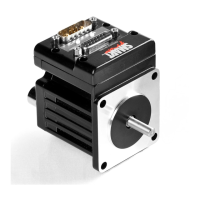Moog Animatics SmartMotor™ Developer's Guide,Rev. L
Page 120 of 909
Introduction
All SmartMotor™ commands are grouped by function with the following notations:
# Numerical integer value, constrained by command. For
example, 0, 1,..22.
formula (or frm) Formula or number. For example, 123 or a=1 or a=(2*3)-1.
expression (or exp) Simple expression or number. For example, a+3 or al[1] or 5.
W (Capital W letter by itself.) Refers to "Word", or 16 bits of
information. Option for addressing I/O 16-bit status words.
mask (or msk) The mask value of the bits that will be affected when working
with integers can typically be passed into a command as an
expression. Mainly used for I/O and status word bit manip-
ulations. For details on binary data, see Binary Data on page
861.
NOTE: In the command syntax, when optional bracketed arguments are shown, the
comma within the brackets is only used with the optional argument. For example,
the comma is used with the optional "m/s" argument in the command MFSLEW
(distance[,m/s]).
Enter the following commands in the Terminal window to move the SmartMotor:
EIGN(2) 'Disable left limit
EIGN(3) 'Disable right limit
ZS 'Reset errors
ADT=100 'Set target accel/decel
VT=100000 'Set target velocity
PT=300000 'Set target position
G 'Go, starts the move
NOTE: A complete move requires: a position, a velocity and an acceleration,
followed by a G (Go) command.
On power-up the motor defaults to position mode. Once Acceleration-Deceleration Target
(ADT) and Velocity Target (VT) are set, simply issue new Position Target (PT) commands,
followed by a Go (G) command to execute moves to new absolute locations. The motor does
not instantly go to the programmed position, but follows a trajectory to get there. The
trajectory is bound by the maximum target velocity and target acceleration parameters. The
result is a trapezoidal velocity profile, or a triangular profile if the maximum velocity is never
met.
NOTE: Position, velocity and acceleration can be changed at any time during or
between moves. However, the new parameters only apply when a new G command
is sent.
Part 1: Programming: Introduction

